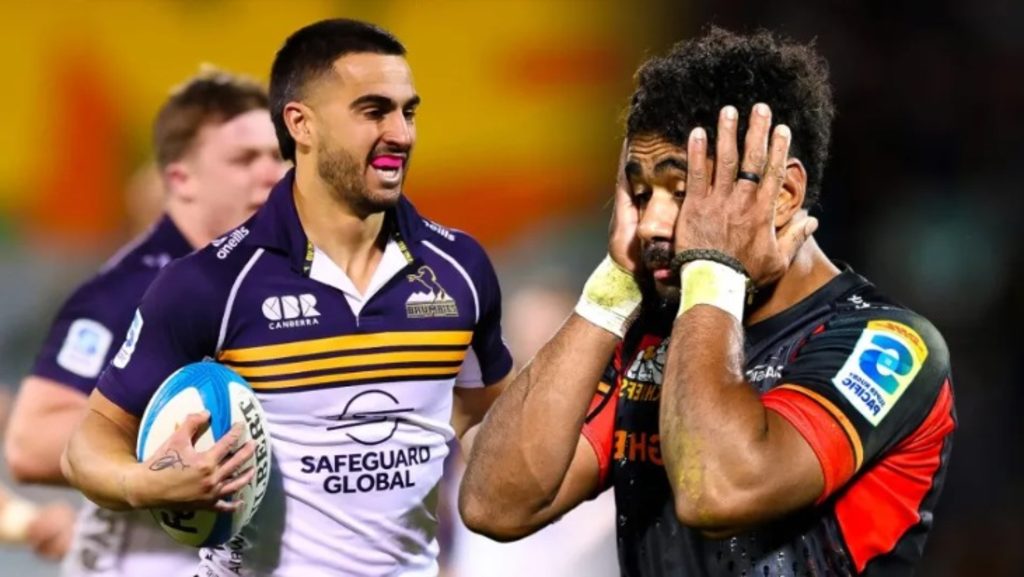If you look at the Brumbies and Chiefs’ seasons to date, the gap between the two certainly looks bigger than a few inches, but when they are compared side-by-side, it’s clear this semi-final will be won by the smallest of margins.
The Chiefs are the favourites for sure. Home field advantage and a 49- 34 thumping in the same fixture back in March gives them an edge.
Not only does history favour them, but they also welcome back three All Blacks to the starting side: captain Luke Jacobson, inside centre Quinn Tupaea, and wrecking-ball Wallace Sititi at No.8.
The Brumbies, on the other hand, have named an entirely unchanged matchday-23 for the do-or-die fixture, putting their faith in their systems and cohesion.
This confidence in their combinations also speaks to the consistency and planning that has gone into the entire season from Brumbies head coach, Stephen Larkham.
“[C]onditions played a part in tonight’s game. We certainly have a game plan which is suited to wet weather, we’re pretty good at putting a contestable up and chasing it, and putting pressure on that breakdown,” Larkham said after their 39-26 win over the Queensland Reds in round 9.
This mindset is a massive mindset shift from Larkham and his game drivers, and it would be dismissive of their preparation throughout the season to ignore how they’ve tweaked their game plan for each opponent, and this weekend, the tweaks are all about the Chiefs.
This feeds into their attack structures, as the Chiefs and Crusaders are the two sides in the semi-finals to score off kick-returns the most, the Brums cannot afford to be inaccurate with their 22m exits, nor kick in panic.
Once the ball has been retrieved, the Chiefs will take their attack down a 15m channel, and this is where their game plan comes to life, particularly against a side like the Brumbies, who run a rush defence.
The Chiefs attacked the blindside 14.9 per cent of the time across the regular season, only the Blues and the Crusaders attacked it more (15.8 and 17.1 per cent, respectively).
In their quarter-final, the Chiefs struck the blindside on 24 per cent of their plays, the highest of any Super side in the last five years.
This is crucial information for Larkham’s Brumbies as any rush defence defends the player, not the space like a drift defence, so should the Brumbies be caught short on a 15m blindside, the Chiefs will punish them.
The men from Waikato have a plethora of attacking weapons they can unleash to get gainline ball or linebreaks.
The Brumbies notably minimised the rush element of their defence against the Canes last weekend, as it resulted in too many missed tackles and linebreaks in their round 11 game against the Wellington side.
Although it may seem like a good tactic to redeploy this weekend, it would in fact be a grand mistake, because giving an experienced campaigner like Damian McKenzie time is simply not an option.
McKenzie thrives at Super Rugby because there is more time; more time before defences hit you, more time between rucks to survey the options, more time to make decisions.
The worst thing to do is to allow the Chiefs, with McKeznie at the helm, to get settled into their pattern, so the Brums must bring back an aggressive, targeted line speed and contestable kicking game, because giving the Chiefs’ back-three space and time is a sure way to concede points.
This brings us to the next key area, the kicking battle. The forecast says it will be a balmy 14 degrees with almost a 50 per cent chance of rain in Hamilton, kicking will be crucial.
The Brumbies’ competitive boxkicks and up-and-unders undid the Blues in round 4, allowing the men from the bush capital to finally break the Eden Park hoodoo.



